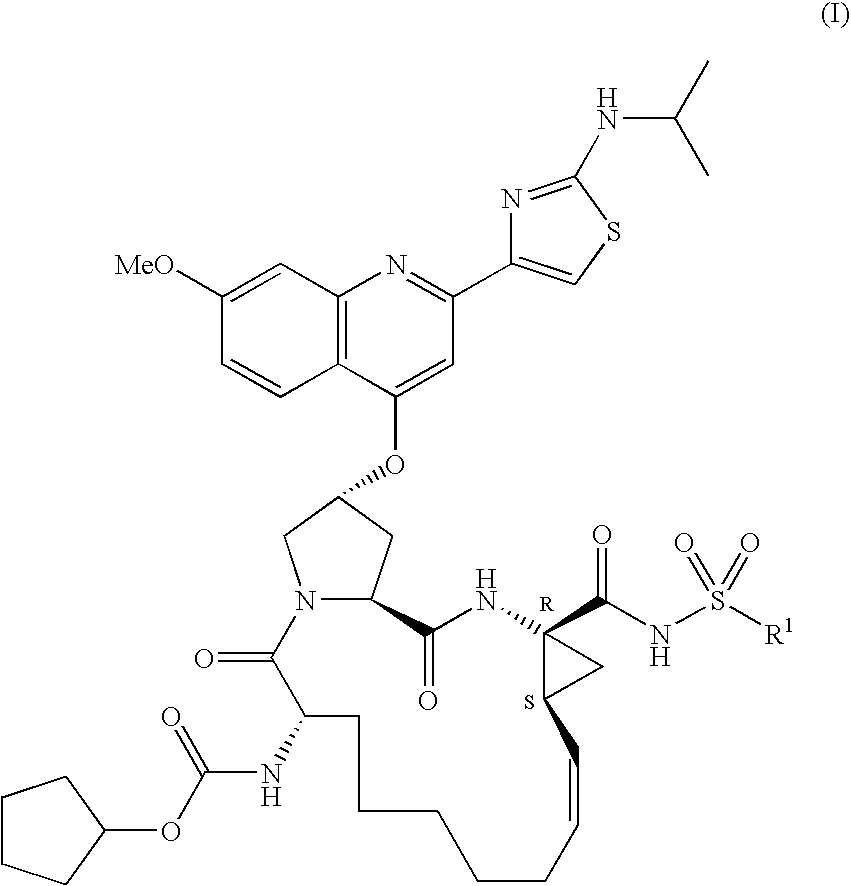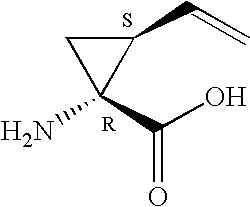Macrocyclic peptides active against the hepatitis C virus
a peptide and macrocyclic technology, applied in the field of compound, can solve the problems of lack of effective, recommendation of immunoglobulin treatment, and lack of cellular and humoral immune responses in protecting against hcv infection and disease, and achieve the effects of not showing significant inhibitory activity, reducing the activity of ns3 protease, and enhancing the stability of the formulation compound or its delivery form
- Summary
- Abstract
- Description
- Claims
- Application Information
AI Technical Summary
Benefits of technology
Problems solved by technology
Method used
Image
Examples
example 1
A mixture of Boc-hydroxyproline 1a (50.0 g, 216 mmol), (1R,2S)-vinyl-ACCA hydrochloride 1b (42.25 g, 238 mmol), TBTU (76.36 g, 238 mmol) and DIPEA (113 mL, 649 mmol) in DMF (800 mL) was stirred at R.T. under a nitrogen atmosphere. After 3.5 h, the solvent was evaporated and the residue extracted with EtOAc and washed with hydrochloric acid (10%), saturated sodium bicarbonate and brine. The organic phase was then dried over magnesium sulfate, filtered and evaporated to afford an oil. Drying the oil overnight (18 h) under high vacuum gave the dipeptide 1c as a yellow foam (72.0 g, 94%, purity >95% by HPLC).
example 2
The dipeptide 1c (72.0 g, 203 mmol), triphenylphosphine (63.94 g, 243.8 mmol, 1.2 equiv.) and 4-nitrobenzoic acid (41.08 g, 245.8 mmol, 1.2 equiv) were dissolved in dry THF (1.4L) and the stirred solution cooled to 0° under a nitrogen atmosphere. DEAD (38.4 mL, 244 mmol, 1.2 equiv.) was then added dropwise over 45 min and the reaction allowed to warm to R.T. After 4 h, the solvent was evaporated and the residue divided into four portions. Each of these was chromatographed over fine silica gel (10-40 μm mesh, column diameter 12 cm, column length 16 cm) using a gradient of 2:1 hexane / EtOAc to 1:1 hexane / EtOAc to pure EtOAc. Ester 2a was obtained as an amorphous white solid after evaporation of the solvents and drying under high vacuum at 70° for 1 h (108.1 g, quantitative yield).
example 3
The nitrobenzoyl ester 2a (108.1 g, 203.1 mmol) was dissolved in THF (1.0L) and the resulting solution cooled to 0°. A solution of lithium hydroxide monohydrate (10.66 g, 253.9 mmol) in water (225 mL) was then added rapidly and the reaction stirred at 0° for 30 min. after which time the remaining base was neutralized with hydrochloric acid (1 N, 50.8 mL). Additional acid was slowly added until the yellow color dissipated (7 mL). The resulting mixture was then evaporated and the residue extracted with EtOAc (3×150 mL) and washed with saturated sodium bicarbonate (150 mL) and brine (150 mL). The organic phase was dried over magnesium sulfate-charcoal, filtered through diatomaceous earth and evaporated. Overnight drying of the residue under high vacuum yielded the alcohol 3a as a colorless foam (70.1 g, 98%, purity >99% by HPLC).
PUM
 Login to View More
Login to View More Abstract
Description
Claims
Application Information
 Login to View More
Login to View More - R&D
- Intellectual Property
- Life Sciences
- Materials
- Tech Scout
- Unparalleled Data Quality
- Higher Quality Content
- 60% Fewer Hallucinations
Browse by: Latest US Patents, China's latest patents, Technical Efficacy Thesaurus, Application Domain, Technology Topic, Popular Technical Reports.
© 2025 PatSnap. All rights reserved.Legal|Privacy policy|Modern Slavery Act Transparency Statement|Sitemap|About US| Contact US: help@patsnap.com



